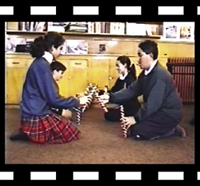|
 |
| |
The assessments
included twenty-four tasks in which students were asked to display their
personal movement skills, appropriate to a range of situations and environments.
These activities often involved the use of equipment, such as balls,
bats, and skipping ropes, in addition to physical coordination.
Twenty tasks were identical for year 4 and year 8 students, two were
administered to both years but with some components deleted for year
4 students, and two were administered only to year 8 students. Eight
are trend tasks (fully described with data for both 1998 and 2002),
five are released tasks (fully described with data for 2002 only), and
eleven are link tasks (to be used again in 2006, so only partially described
here).
The tasks are presented in the three sections: trend tasks, then released
tasks and finally link tasks. Within each section, tasks administered
to both year 4 and year 8 students are presented first, followed by
tasks administered only to year 8 students.
Averaged across 88 task components administered to both year 4 and year
8 students, 16 percent more year 8 than year 4 students succeeded with
these components. Year 8 students performed better on all except six
of the components. The smallest differences generally occurred on task
components that focused on technique, with the largest differences on
task components that emphasized speed and precision.
Trend analyses showed no meaningful change since 1998 for year 4 or
year 8 students, with just a hint of a decline for year 8 students.
Averaged across 37 task components attempted by year 4 students in both
years, the same percentage of students succeeded in 2002 as in 1998.
Gains occurred on 15 components and losses on 17 components. At year
8 level, with 39 task components included in the analysis, 2 percent
fewer students on average succeeded with the task components in 2002
than in 1998. Gains occurred on 11 components, with losses on 25 components.
|
